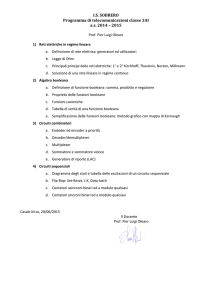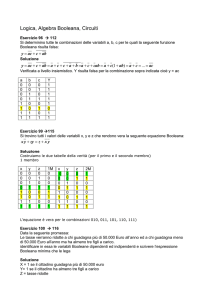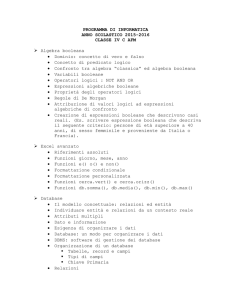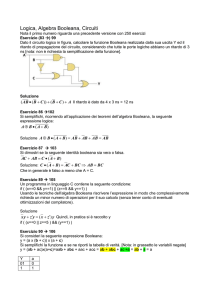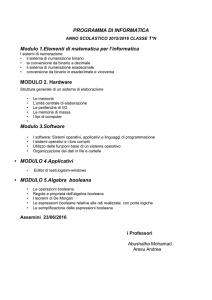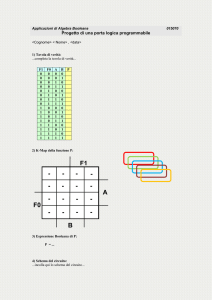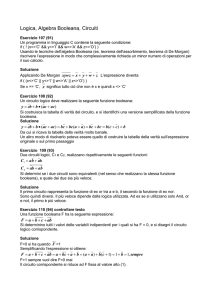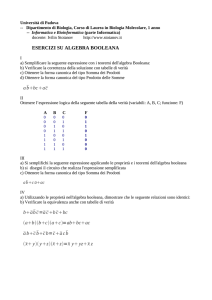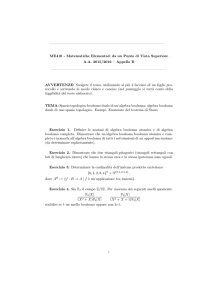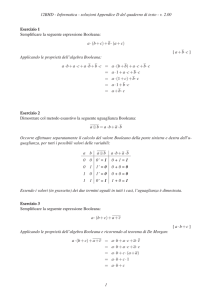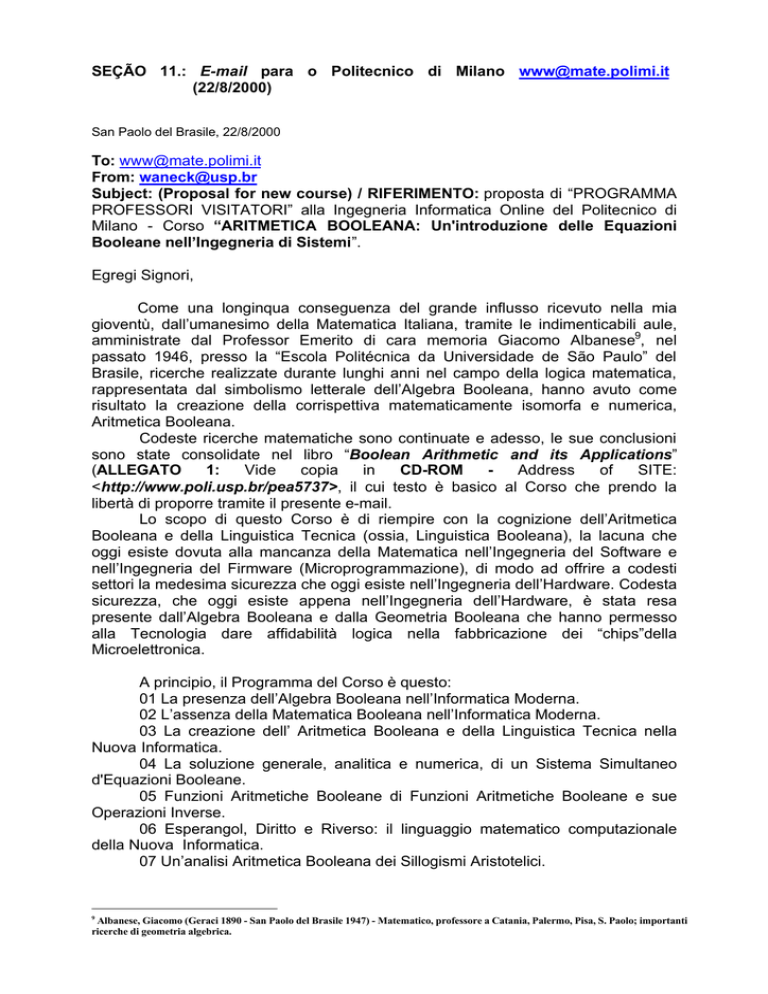
SEÇÃO 11.: E-mail para o Politecnico di Milano [email protected]
(22/8/2000)
San Paolo del Brasile, 22/8/2000
To: [email protected]
From: [email protected]
Subject: (Proposal for new course) / RIFERIMENTO: proposta di “PROGRAMMA
PROFESSORI VISITATORI” alla Ingegneria Informatica Online del Politecnico di
Milano - Corso “ARITMETICA BOOLEANA: Un'introduzione delle Equazioni
Booleane nell’Ingegneria di Sistemi”.
Egregi Signori,
Come una longinqua conseguenza del grande influsso ricevuto nella mia
gioventù, dall’umanesimo della Matematica Italiana, tramite le indimenticabili aule,
amministrate dal Professor Emerito di cara memoria Giacomo Albanese9, nel
passato 1946, presso la “Escola Politécnica da Universidade de São Paulo” del
Brasile, ricerche realizzate durante lunghi anni nel campo della logica matematica,
rappresentata dal simbolismo letterale dell’Algebra Booleana, hanno avuto come
risultato la creazione della corrispettiva matematicamente isomorfa e numerica,
Aritmetica Booleana.
Codeste ricerche matematiche sono continuate e adesso, le sue conclusioni
sono state consolidate nel libro “Boolean Arithmetic and its Applications”
(ALLEGATO
1:
Vide
copia
in
CD-ROM
Address
of
SITE:
<http://www.poli.usp.br/pea5737>, il cui testo è basico al Corso che prendo la
libertà di proporre tramite il presente e-mail.
Lo scopo di questo Corso è di riempire con la cognizione dell’Aritmetica
Booleana e della Linguistica Tecnica (ossia, Linguistica Booleana), la lacuna che
oggi esiste dovuta alla mancanza della Matematica nell’Ingegneria del Software e
nell’Ingegneria del Firmware (Microprogrammazione), di modo ad offrire a codesti
settori la medesima sicurezza che oggi esiste nell’Ingegneria dell’Hardware. Codesta
sicurezza, che oggi esiste appena nell’Ingegneria dell’Hardware, è stata resa
presente dall’Algebra Booleana e dalla Geometria Booleana che hanno permesso
alla Tecnologia dare affidabilità logica nella fabbricazione dei “chips”della
Microelettronica.
A principio, il Programma del Corso è questo:
01 La presenza dell’Algebra Booleana nell’Informatica Moderna.
02 L’assenza della Matematica Booleana nell’Informatica Moderna.
03 La creazione dell’ Aritmetica Booleana e della Linguistica Tecnica nella
Nuova Informatica.
04 La soluzione generale, analitica e numerica, di un Sistema Simultaneo
d'Equazioni Booleane.
05 Funzioni Aritmetiche Booleane di Funzioni Aritmetiche Booleane e sue
Operazioni Inverse.
06 Esperangol, Diritto e Riverso: il linguaggio matematico computazionale
della Nuova Informatica.
07 Un’analisi Aritmetica Booleana dei Sillogismi Aristotelici.
9
Albanese, Giacomo (Geraci 1890 - San Paolo del Brasile 1947) - Matematico, professore a Catania, Palermo, Pisa, S. Paolo; importanti
ricerche di geometria algebrica.
08 Deduzione di Testi e un’Analisi Aritmetiche Booleane della Matematica
Riversa di Hilbert.
09 La Computazione “Non-Von Neumann”.
10 Il Modello Matematico della Computazione “Von Neumann”.
Come conseguenza di queste ricerche, abbiamo ottenuto la creazione
dell’ Aritmetica Booleana, matematicamente isomorfa all’Algebra Booleana, il cui
linguaggio letterale è totalmente sostituito dal corrispettivo simbolismo numerico del
linguaggio aritmetico delle cifre "0/1”. Questo ha reso possibile l’ottenimento di una
completa e generale soluzione di qualsiasi Sistema d'Equazioni Booleane, non
ancora ampiamente diffuso, essendo un argomento di gran rilievo per la Logica
Matematica Computazionale.
D’altra parte, l’ Aritmetica Booleana ha reso possibile la creazione
della Linguistica Tecnica (ossia, Linguistica Booleana), causando l’arrivo di un unico
linguaggio computazionale matematico che ho denominato “Esperangol” 10
(Vide Capitolo 9 pagg. 291-312 – del ALLEGATO 1).
2.
I risultati ottenuti in queste ricerche si trovano riassunti nell’ALLEGATO
Penso che le Aree d’Interesse per il Corso potrebbero essere le
seguenti: Matematica Applicata, Ingegneria d’Energia ed Automazione Elettrica,
Ingegneria Elettronica, Ingegneria Meccanica, Ingegneria Meccatronica, Ingegneria
di Hardware, di Software e di Firmware e Interesse Generale.
Nella fiduciosa attesa che la promissiva evoluzione riferita di queste
ricerche, frutto longinquo delle aule ripiene d’umanesimo della Matematica
Italiana profferite presso la Escola Politécnica da Universidade de São Paulo
dall’indimenticabile e di grata memoria Dottor Giacomo Albanese che nel
passato 1946 ha fatto destare in me l’attenzione ai problemi concettuali dei
Fondamenti della Matematica, renda possibile e pertanto si possa realizzare, la
presente offerta del Corso Proposto come Professor Visitatore.
(b) Professor Wagner Waneck Martins
e-mail: [email protected]
Indirizzo Postale: Rua Barão de Itaúna, 155
05078-080 - São Paulo - SP - BRASIL.
Telefono: 0055011 3836-4641 Fax: 0055 011 3836-4703 Telefono Cellulare: 0055
011 9262-0847
e-mail: <[email protected]>
ALLEGATI:
ALLEGATO
1:
Vide
copia
in
CD-ROM
Address
of
SITE:
http://www.poli.usp.br/pea5737, nella cui parte finale c’è il “Curriculum Vitae”
dell’autore.
“Esperangol”; Questo nome è stato dato per ricordare “Esperanto”, nome dato da Zamenhof, il creatore di codesto linguaggio universale nel 1887 –
Zamenhof, Ludwig Lazarus (1859-1917).
10
ALLEGATO 2: The results of this lifetime research carried out at University of São
Paulo - Polytechnic School - Department of Electrical Energy and Automation
(Abstract).
ALLEGATO 2
The results of a lifetime research carried out at University of São Paulo Polytechnic School - Department of Electrical Energy and Automation
(Abstract).
"Esperangol" replaces the present chaotic Machine Language since it is based
on Mathematical Machine Language and therefore, it is Universal as well as being
UNIQUE.
I believe that people would be very interested in "Esperangol", a direct and
reversible computer language, due to the following:
1st.: This new language makes the introduction of any kind of "virus" in the
computer process, impossible;
2nd.: It allows the automatic production of software mathematically free of
failures caused by human factors;
3rd. : It allows complete safety in computer real time operation, where there will
be no more need of the "Ctrl+Alt+Del" keys.
I think that even many circumstances might have been changed in these last
years, until now, there was no interruption in the research carry out at that University.
Although there was an incredible development of Information Science during this
past time, solutions of some problems have not been found yet. These main
problems are:
.The chronic crisis in real time software;
.The present viral proliferation in the sector;
.The lack of common nucleus in the different applications of Artificial
Intelligence;
.The unobtainable software automatically free,
.The fifth generation computer system.
For these reasons, the research relative to this Pure Mathematical Field, led
me to find a new area of studies, called Boolean Arithmetic, mathematically
isomorphic to the Boolean Algebra, where problems mainly aroused by current
computer language into the operations system, can be studied and solved. Then, a
draft of my new book on “Boolean Arithmetic and its Applications” now is ready,
whose CD-Rom copy is in the SITE: http://www.poli.usp.br/pea5737. Its CONTENTS
presents some results of the researches, referring to the author’s Curriculum Vitæ
inside annexed. This present enlarged work shows that Boolean Arithmetic solves
problems using only bits. But, and as it is a mathematical logical system, it may
prove to be a valuable instrument in remodeling computer programming in order
to avoid the current computer languages, which may cause problems to the
operational system.
I think that my approach via Boolean Arithmetic can be transformed in a
valuable instrument in remodeling computer programming. Nowadays, Software
Engineering programs are empirically developed. I may say that Mathematics is
not yet used in Programming, whereas, Hardware Engineering is strongly based in
Boolean Mathematics, through the algebraic and geometrical isomorphic aspects.
This Boolean Arithmetic could be useful in searching solution for current problems in
the computer operation of any software or firmware engineering programs. The
same safety operation which we have in the hardware computing can be
achieved in the operation of the software and firmware computing, without any
logical “bug” which blocks the computer operation.
For this purpose in Chapter 5 of the referred CD-Rom copy of “Boolean
Arithmetic and its Applications”, I presented the 2nd Example (pp. 142-146) and
the 3rd Example (pp. 146-151), which represent graphically a part of a general
computing program. These simple examples show us that incompatibility, may cause
logical “bug”, and are not due to HUMAN FACTORS as it is ordinarily admitted.
These examples solved by Analytical Method are repeated in Chapter 6 (pp. 162172), using numerical method as Partition Method, Doubling Operators, etc. The idea
is to maintain the Nodal Decisions when the “forbidden eras”, could be
technologically eliminated. In Section “11.2 – THE NODAL AUTOMATIC
TRANSITION ANALYSIS (NATA)”, these examples are again repeated as a Problem
on pp. 355-369, with more details, using the BAF(BAF) properties of Chapter 7
(pp.179-266). It was shown how these “bugs” can be mathematically eliminated
without any alteration in the CONCLUSION (or, NODAL DECISION) of that part
of programming.
The last Chapter of the “Boolean Arithmetic and its applications”, refers to
my book, “ESÇÃO (n~m~p): A Non-Von Neumann Computer”, published in 1985.
The mathematical fundamentals of that Non-Von Machines and Non-Von
Programming Styles which was seen in the previous Sections of the referred book
“Boolean Arithmetic and its applications”, can be found in some publications
referred in p.457, based on the last book. Other publications as referred on p.457,
show the mathematical fundamentals of that Non-Von Machines and Non-Von
Programming Styles, which enable us to find the solution for the problem.
I think, in conclusion, that the most important part of this book is that it
probably allows:
1st To establish that any pure sequential program can be recorded into
a simple EPROM chip or CD-ROM device, without use of any current
computational language;
2nd To establish a true Mathematical Model to the current Von Neumann
Machines in order to eliminate the current logical bugs, mainly in the real time
applications without the ordinary use of empirical methods. This elimination is
guaranteed with some data alterations, but without any modification in its
formal logical nodal decisions;
3rd To establish a true Non-Von Mathematical Model, with the
elimination the microprocessor as a subsystem of the present computational
machines. Thus, it will remain only the memory unit and the respective
input/output devices. Then, the “Von Neumanns’s bottleneck” disappears,
establishing a pure parallel processing without any resource to the present
situation;
4th To establish a mathematical programming in the field of the
hardware, software and firmware engineering, with the creation of a Technical
Linguistics in the adequate field of the Negative Logic;
5th To re-establish new lines of logical mathematical researches in the
field of Information Sciences, which has been broken since 1938 in Shannon’s
time, with the Mathematical Von Neumann Deviation, as it was described in
Chapter 13 (p. 416);
6th To establish promising researches in the field of the Reverse
Mathematics, as it was seen as an application in Chapter 11 (p. 344) in the
sense of Hilbert’s Program proposal;
7th To establish new promising researches in the field of Quantum
Logic Gates of Quantum-Mechanical Computers, since it is possible to
establish the Mathematical Model as a Quantum-Mechanical Non- Von
Computers;
8th To establish new promising researches in the field of Genetics
through Boolean Mathematical Models in computing applications of the
Theoretical Biology. The Text Deduction of the Chapter 11, for instance, could
be suggested its use instead of the computing of empirical models and
isolated facts.
Thus, paradoxically, the absence of mathematics in the Information Science,
which revealed the 4th Great Crisis in Mathematics and allowed the extraordinary
technological development, began to demand in its growing and wide employment of
the logical artificial thought, more and more fundamentals of the utilized scientific
true.
e-mail: [email protected]

